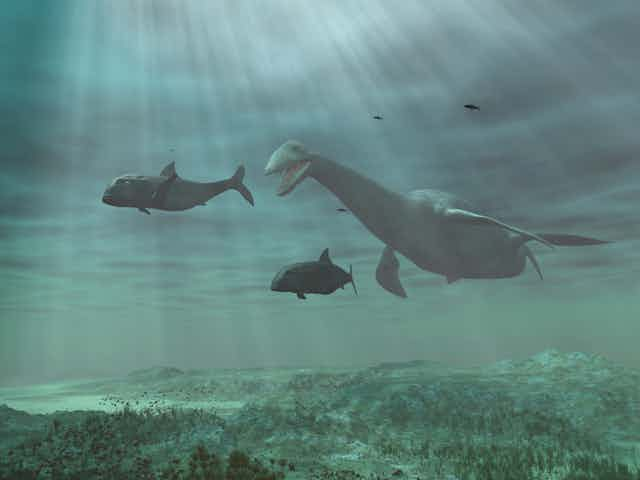For billions of years, life on Earth remained relatively simple. Only single-celled organisms that could live with little or no oxygen were able to survive in the seas.
Eventually, the rise of oxygen led to a proliferation of diverse, multicellular life. However the oceans have not remained unchanged since that chemical and biological revolution. At several times in geological history, they have partially reverted back to their original bacterially-dominated, oxygen-free state – and they could do so again.
Today rising CO2 levels are making the oceans warmer and more acidic. Deforestation and intensive farming are causing soils and nutrients to be flushed into the sea. And increasingly, the oceans are being stripped of oxygen, leaving large “dead zones” in the Gulf of Mexico, the Baltic Sea and the Atlantic off West Africa.
These dead zones, smaller-scale revivals of the primeval oceans that existed before complex life, appear to be caused by poor land management, such as fertilisers draining from farms into the sea. It is a process that could be exacerbated by climate change – as has happened in the past.
How oceans become ‘dead’
Oceans lose their oxygen when animals and bacteria consume it faster than it can be replenished. This usually comes about in stagnant or algae-rich waters.
In severe cases, all oxygen can be consumed rendering the waters “anoxic” and inhospitable to animal life. This happens today in isolated fjords and basins. And it has happened on a larger scale throughout Earth’s history, especially during the Cretaceous, towards the end of the dinosaur era 145-66m years ago. Then, large parts of the ancient oceans became anoxic, allowing vast amounts of organic matter to escape degradation, and in many cases forming deposits of oil and gas.

We can examine the extent of anoxia by looking for a certain type of “green sulfur bacteria” which require both sunlight and oxygen-depleted waters in order to conduct their rather exotic form of photosynthesis. Evidence of their presence can be found in ancient rocks – molecular proof that anoxia once extended from the seafloor almost all the way to the ocean’s surface.
These oceans thrived with microbial life. But animals need oxygen, and vast portions of these ancient oceans would have become “dead” to them.
Life in the deep sea
Unlike almost every other ecosystem on our planet, the deep sea is bereft of light and plants. Animals down there largely live off marine snow, the scraps of organic matter that somehow escape from the surface world and sink to the twilight realm below. In this energy-starved world, creatures live solitary lives in emptiness, darkness and mystery.
And yet life is there. Krill thrive on the slowly-sinking snow. Sperm whales dive deep to consume the krill and emerge with scars from giant squid. And when a whale dies and its carcass plummets to the seafloor, it is set upon by sharks and fish who emerge from the darkness for the unexpected feast. Within days the carcass is stripped to the bones – but even then, massive colonies of tube worms spring to life.
All of these animals, the fish, whales and worms, depend on oxygen. Our oxygen-rich seas are an incredible contrast to the North Atlantic during some anoxic events. Then, plesiosaurs (pictured at the top) and ichthyosaurs, feeding on magnificent ammonites, would have been confined to the sunlit, oxygen-rich realm near the surface, their maximum depth of descent marked by a layer of pink and then green water, pigmented by bacteria. And below it, where the deeper waters were anoxic, only single-celled organisms.
Could this happen again?
Conventional wisdom has been that such extreme anoxia in the future is unlikely, that Cretaceous “dead zones” were a consequence of a markedly different geography. The ancient Atlantic Ocean was smaller and more restricted, lending itself to these extreme conditions. This is a bit like the modern Black Sea, a restricted basin where fresh river water sits stably above salty and dense marine deep water.

But the Black Sea doesn’t quite match up with what we know about ancient anoxic oceans. For a start, if driven solely by geographical shape, why were the oceans not anoxic as the norm rather than only at certain times? Sometimes much larger oceans became dead zones, or the anoxia was restricted to coastal areas. And although ocean circulation was slower during warm climates, it did not stop – unlike in the Black Sea.
This suggests geography was important but not exclusively so. Algal blooms are a more likely trigger. These algae would have flourished after dramatic increases in nutrients caused by erosion and chemical weathering, driven by higher carbon dioxide concentrations, global warming and/or changes in the hydrological cycle – all of which we now know occurred prior to several anoxic events.
It is likely that today’s coastal dead zones are due not to climate change but to our excessive use of fertilisers. And it is unlikely that our future will revisit the widespread ocean anoxia of the past. But the lessons of the past do suggest global warming could exacerbate the impacts of our poor land management, adding yet another pressure to already stressed ecosystems.
A longer version of Richard Pancost’s article appears on the Cabot Institute blog.

